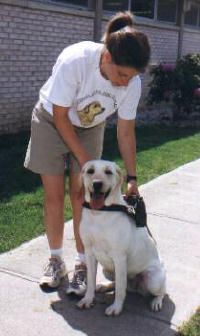On the Job and After Hours
Guide dogs enjoy their work immensely, and they get a lot of satisfaction from a job well done, but there is no room for typical dog fun during the work day. Games, treats and praise distract the dog from helping its handler navigate the course. Even when the handler doesn't need assistance, a guide dog on the job is trained to ignore distractions and keep still. This is because a guide dog must be able to come to the handler's workplace or be in public places without creating a disturbance.
When you see a guide dog on the job, it is extremely important that you recognize that it is at work. Petting or talking to the dog breaks its concentration, which impairs the handler's ability to get around in his or her surroundings. People are very impressed with guide dogs and so we have a natural inclination to praise them, but the best thing you can do to help a guide dog is to leave it alone so that it can pay attention to its surroundings and maintain its focus on its handler. Guiding is very complicated, and it requires a dog's undivided attention.
Advertisement
When a guide dog gets home at the end of the day, however, it will play and soak up praise just like an ordinary pet. Guide dogs make the distinction between work and play based on their lead harness: When the harness is on, they must stay completely focused -- when it comes off, it's play time. Guide dogs work very hard every day, but they lead extremely happy lives, full of lots of attention and stimulation. Dogs only end up working as guide dogs if they absolutely love the work. In fact, many handlers report that their dogs leap enthusiastically into the harness every morning!
